What I Saw – by Jackie Philpott

Spaulding Marine Center
In early December I drove over to Spaulding Marine Center’s annual holiday party in Sausalito. It used to be called Spaulding Wooden Boat Center, but now it is a boat yard that offers just about everything to any kind of boat. It also seems to be a marine-industry community center and favorite go-to place for people who live aboard boats and houseboats in several local marinas.
I arrived early to find dozens of people preparing the center for its annual holiday program. Artists were setting up paintings and photography, stained glass works, jewelry, ceramics and handcrafted woodwork including a polished wooden toolbox with a handle shaped like the beak of a porpoise. It sold first thing, before I could photograph it: The fella who bought it looked like a cat who had just swallowed a big fat canary.
“Wait! What are you going to do with that?” I asked him as he passed me at the top of the stairs.
“I don’t really know yet,” he admitted. “I saw it and had to buy it. It’s too beautiful to use for tools, that’s for sure!”
In Sept. 2023 I had the chance to sit down with members of the Board of Directors for the Master Mariners including Terry Klaus, Diane Brendan, Bob Rogers and Peter English. They told me about their early involvement in Spaulding. It is always entertaining to listen to sailors’ colorful descriptions of early beginnings of organizations that become more respectable as they age. Sailors are such great storytellers. Nowadays Spaulding seems positively staid compared to the stories I heard from Mr. Klaus et al.
Pete Brewster
Before the party began, I wandered upstairs with my camera. I’ve said it before: When people see a camera, they know something is up. Pete Brewster came right over and introduced himself as Spaulding’s yard manager.
I have rarely interviewed someone off the cuff who was so articulate. Pete speaks in full sentences; his focus is remarkable and all I had to do was smile and pay attention.
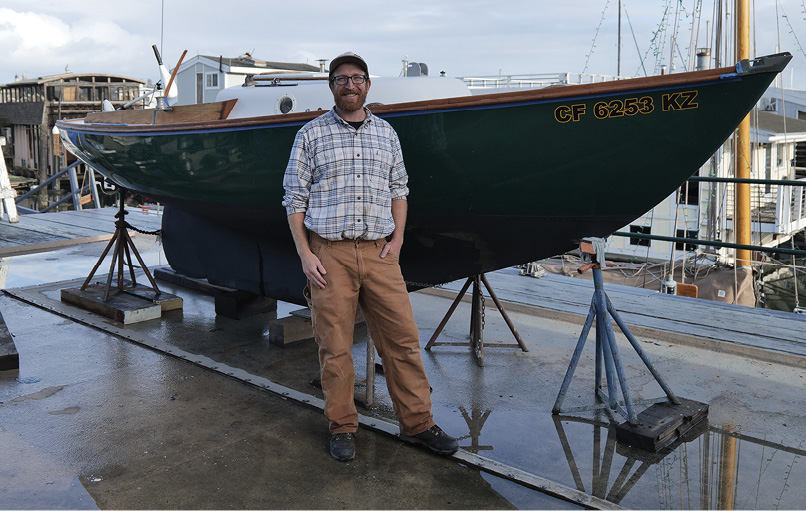
Pete and I briefly discussed the youth sailing programs around the Bay, which are pretty much focused on racing. Then I asked Pete about himself and here’s what he said:
Pete: I have a background in sailing education. I was a sailing instructor for ten years. I ran a program up on the west shore of Lake Tahoe. The City Department of Parks and Recreation manages the Tahoe Community Sailing. The home base is right next to Obexer’s Marina in Homewood on the West Shore. That program focuses more on sailing than racing. During both sailboat racing and learning programs boats get bumped and break. It’s important to know how to fix a boat.
Boatworks 101
Then Pete told me all about Spaulding’s Boatworks 101, which is described on its website in this way: “Boatworks 101 [is] an innovative, first-of-its-kind apprenticeship program that trains the next generation of marine industry craftspeople. The Boatworks 101 training program improves the quality of employment options for young people by offering paid apprenticeship training in a high-need industry in the San Francisco Bay Area and beyond. It also aims to diversify the marine service industry by recruiting and supporting candidates of color, women and other underrepresented populations. Successful completion of Boatworks 101 leads to full-time employment as entry-level marine service technicians and the opportunity to further specialize within the field.”
Pete: With Boatworks 101 we’re focusing, from the beginning, on how to fix a boat, how to maintain a boat, how to do repairs, how to do fiberglass, painting, woodworking, rigging to some degree, engine maintenance, electrical installations, plumbing, thru hulls, propellers and running gear; everything that is needed by a boat. We cover as much as we can, even detailing, buffing and waxing a boat. All those things are skills that are needed for maintaining boats. There are hundreds of thousands of boats in this area. There used to be hundreds of shipyards and now there’s only a small handful and those are starting to die out because of the lack of people to work in them, to sustain these businesses so they can keep going.
We’re trying to train a reliable and quality technician who has the hunger and eagerness to learn more and expand upon this experience. Call it a pre-apprentice apprenticeship. Boatworks 101 covers a broad spectrum of information to give participants an introduction to the marine industry. There’s so much to cover in just a year. There are schools out there for which you have to pay for a one-to-two-year program that is more specialized and focused. We are a broader program. We spend the first nine months to try to give participants access to that broad spectrum of information, which enables them to go out in the last three months to find something that is specialized.
So far everyone (who) has gone to one industry partner has stayed there and then hired on immediately after.
Boatworks 101 accepts six individuals per year, chosen through an extensive interview process. From approximately 20 – 30 applicants, six people were chosen. Our application process opens in April and then ends a month or so later. We select six people at the end of June and they start in August. The in-house training stops in June when graduates go off and work in the industry.
Jackie: So you accept them as apprentices and there’s no cost?
P: There’s a cost to us (of approximately $250,000 per year.) It’s a paid internship. They are paid a low wage while they’re being trained. That’s one of the specialties of our program. It is a paid apprenticeship, it’s not a pay to learn. We are actually paying them. There’s cost to us. We’re training them.
We fundraise with local donors, government grants, local grants and non-profits that help fund these kinds of programs. Anywhere we can, we’re constantly looking for support.
We have a small staff, including Matt Zarem, our general manager, and Lili Jeske, who is our program coordinator. A paid consultant does most of our grant writing. Spaulding is a non-profit so donations are tax deductible. People who donate get tax write-offs. We have had a number of people who would like to donate boats to us. While that is a great idea, we do not have the space to store them. We have limited storage space, too. We’ve built a couple of Pelicans [12-foot centerboard sailboats], which we’ve used to teach kids how to sail, and we have a couple of Pelicans that we’re looking to restore in order to send them off or sell. We do fundraisers and silent auctions.
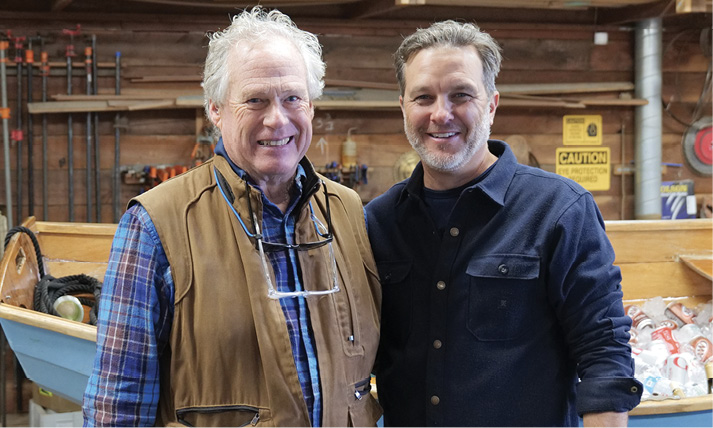
We’re trying to advertise more, but our marketing staff is basically us, so we have limited reach. We’re always looking for help from anyone who is willing to volunteer time. [He laughs and shakes his head.] Our budget is so tight. Lili [Jeske] coordinates the emails and then all of us chime in to create advertisements.
I ask whether Pete would like to be photographed next to his own boat, a Cape Dory Typhoon named Nebulosa. It is always a pleasure to photograph people with their boats. They always look happy that way.
We walked over toward the water and Pete introduced me to Greg, who is below us on the water, carefully stringing Christmas lights up the mast of Freda, preparing her for the Sausalito Lighted Boat Parade the following Saturday.
Pete: We also have volunteer staff who are crazy passionate. Greg is a vital asset to us. He’s helped us significantly and is always here working. We also offer this space for rental to the public for events of their own. We’ve done weddings, baby showers and regular gatherings. In addition to earning money to run our programs, renting out the space on weekends, when we’re not running a boat yard, it offers a way to show off this place, its history.
Pete left me then to go back inside and help set up for the party.
I introduced myself to Lili Jeske, the center’s program director. She and volunteer Dixon Kuhn were preparing to sell big bowls of beef chili for $10. Dixon was in charge of stirring the chili while Lili hacked away at yeasty, locally baked bread. A big chunk of the bread came with the chili.
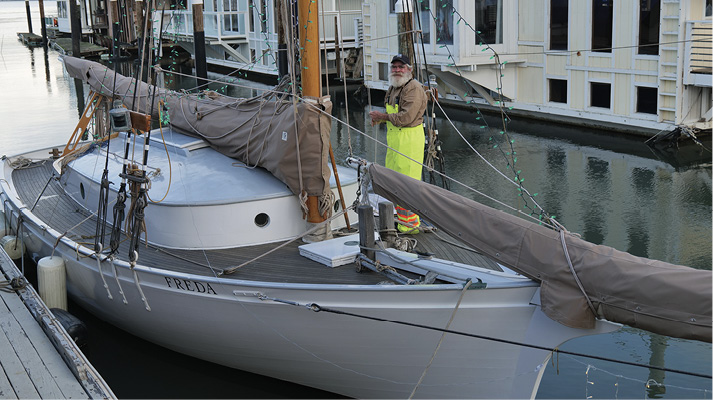
I was encouraged to mention the nearby Davy Jones Deli, which is a particular local favorite, providing both the chili and also vegetarian soup for sale that evening as a fundraiser. Here is a quote from its online site:
“Food is a deeply sensuous experience; not only in tastes, aromas, and sensations, but also in the way it inhabits our stories, our landscapes. It has the ability to bridge gulfs between people, to bring us together through this simple act of eating. When treated artfully, that simple act ascends to something more profound and meaningful: coloring and illuminating our lives together. Creating and consuming food is joy, love, and community when approached thoughtfully.”
Now that, ladies and gentlemen, is quintessential Marin food-talk. The owner of the Deli, David Johnson, is a significant donor to the Center and four people asked me to mention his generosity. Mr. Jones is also a member of the band that played that evening, called The Hot Clams. It is a vintage jazz band that plays music from the 1920s through the 1950s. David Johnson plays guitar and sings; Gavin Smith plays clarinet and also sings. Scott Lipsitz plays what is described as “uprighteous bass.” There is also a drummer, but I didn’t get his name. There was a second guitarist this night. The Hot Clams is a terrific band, and much appreciated by everyone that evening.
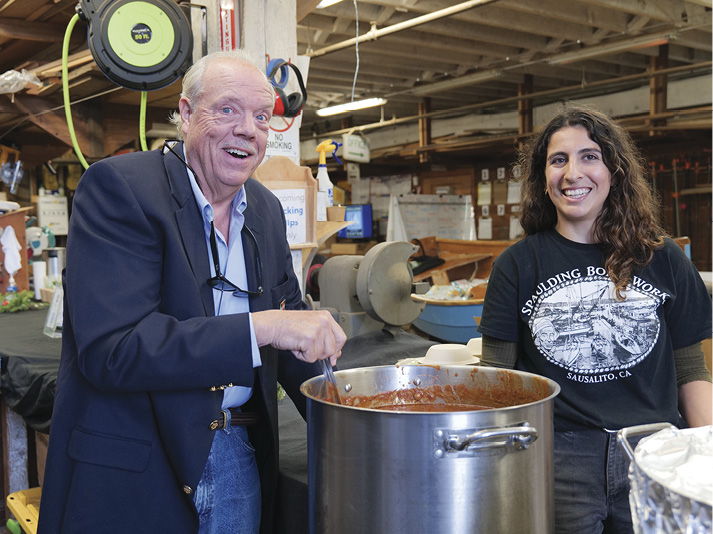
Volunteer Collette Ireland, dressed like an elf, helped Santa distribute drinks. I think Ken Frank was inside the Santa suit that evening. Back in 2022 I was loitering aboard my sailboat on I dock in Owl Harbor when Ken arrived aboard his 25-foot sailboat in the slip next to mine. It was a very hot day, and his crew immediately ditched him for somewhere air conditioned. I waited awhile, then knocked on the hull of his boat to introduce myself to my new neighbor.
“I can’t get up right now. I’m recovering from heat stroke!” called Ken. Under the circumstances, I was impressed by his poise and nice manners. It was nice to see him again on this evening in Sausalito.
I really enjoyed my chat with Laura Holmes and Graham Creasey. They were both wearing silly hats made of felted wool. I complimented Laura and said, “Those are very beautiful hats.”
Graham said proudly, “They are from Peru.”
Laura smiled. “They are from Peru. I bought them in Menlo Park.” We all laughed and agreed that they were beautiful and exotic.
Laura and Graham live on a nearby houseboat, which they call Open Arms. How did they come to be Spaulding fans? Spaulding worked on their 11-foot Whaler, which is named Pirate and the Princess. Laura told me that they row around Richardson Bay together. She rolled her eyes: “People call out, “Oh, how cute!’”
I also had a chat with Dan Cassidy, another houseboat resident in Laura and Graham’s neighborhood, who was displaying his own art. Dan has a studio in the Industrial Center Building, a property adjacent to the Spaulding Center. Local people call it the ICB. Dan told me a bit of the history of the ICB, which contains more than 100 artists’ studios.
You can read about it yourself here: https://icbbuilding.com/history/
I’d offer up my photo of Dan but he asked me not to use his photograph. Witness protection and all that.
There were groups of people all over the place, upstairs and down, and they were all talking about boats. Not the weather, not politics, but that good old safe topic: boats. Three fellas stood next to where Santa and his elf were providing sailor libations. After eavesdropping for a couple of minutes, I introduced myself and then all four of us were talking about boats. It was turning into my kind of a fine evening.
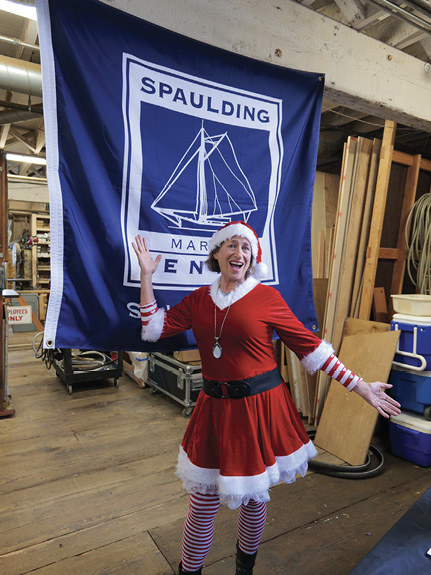
Don Ketman has a 33-foot Spaulding yacht. Yes, there is a Spaulding yacht, and it has beautiful lines. His boat’s name is Auroral. If you see her on the water, now you know her provenance.
Then Charley Stern and I had a nice chat about the evening and all the people in attendance. He nodded and said, “There is a lot of affection here.”
We talked about the famous schooner S/V Freda, which was tied up just below the boat yard being lovingly draped with Christmas lights by her own private volunteer, Greg. Freda is the oldest sailboat on the West Coast, built in 1885 in Belvedere for local racing and yachting. She was completely restored by the Arques School of Traditional Boatbuilding, which still has an office at Spaulding.
Charley lives on his boat, a 45-foot Fuji ketch, S/V Peregrine in Lowrie Yacht Harbor in San Rafael. I’ve heard about Lowrie’s, which has been family owned and operated since 1948. It is reached by water via the San Rafael Creek. Charley said, “We call it a canal.” Charley told me that it is currently being dredged and I believe him. His boat has a deep keel and he says he is able to come and go, so it should be safe for everyone to visit now. That’s a long canal and entering it, your boat is usually straight into the wind. I plan to visit, as soon as I have an engine again. I commented about the positive energy that surrounded us, Charley nodded and smiled.
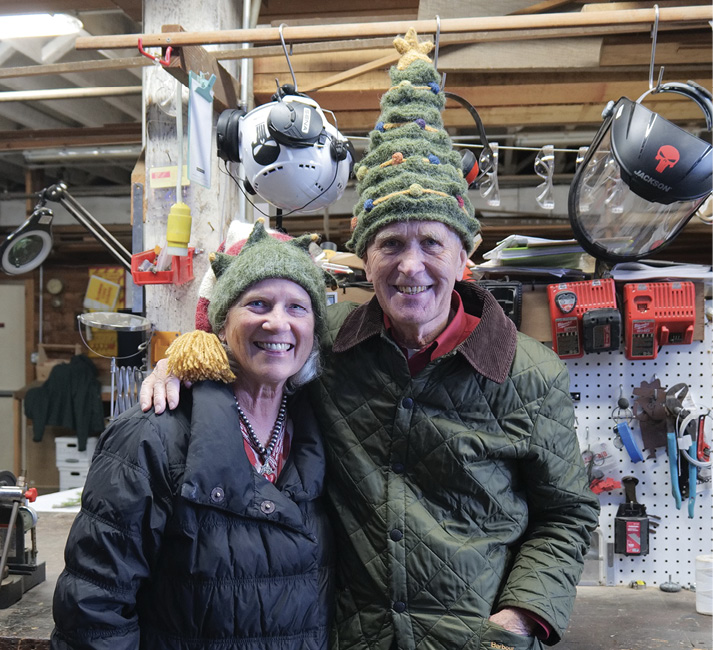
At Spaulding space heaters hung from the rafters above us. Despite their significant warmth, it was still cold. I kept my down jacket and wool hat on all night. What did I expect? It’s a boat yard! I remember visiting a few years ago in the summer and it was a perfect temperature. There are many serious fans of Spaulding, and a lot of them were in attendance. I arrived at about 2:30 and it became really full and loud with happy sounds by 5:40 p.m.
Then I went upstairs! Free books, woodwork, totes made of sailcloth. People were sitting on a couch and standing around behind that, watching a documentary about the restoration of Freda on the big screen television.
Karsten Hansson was stirring and serving chili downstairs. He is a recent graduate of Boatworks 101, currently working as a “marine technician.” What did he have to say about this holiday party? “It is very important for people to support Spaulding.”
When I started to get hungry, I looked around to see what other people were eating. A woman sitting nearby was eating something that looked like donut holes. She told me they were delicious and pointed to a fella who stood near the entrance. I watched Franchero Ellis drop what he calls “bakes” into really hot oil. He told me that bakes are a snack food from Barbados. The sweet ones are made with apples and cardamon, sprinkled with powdered sugar. The others are called savory, made with leeks, fennel and thyme, then drizzled with hot sauce. The sweet ones did taste like donuts, and the other type were good, too. They were yummy and cost $10 for four of each flavor.
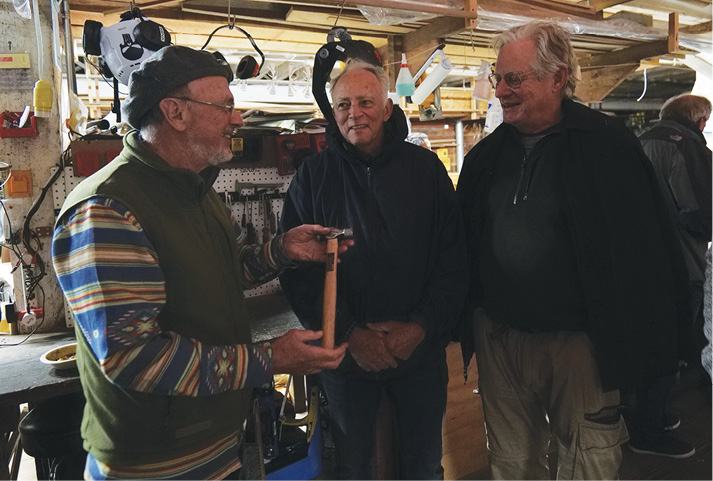
On my way out, as I edged over toward the exit, I saw a pyramid made of Spaulding Marine Center coffee cups. A fella stood behind the table.
Jackie: I’ve always admired those cups.
The fella handed one to me. He said, “Here. Take it.”
J: Aren’t you supposed to be selling those to make money?
Fella: [shrugged] We have so many of them.
Then he smiled at the next customer. Oh gosh. A man who gives away beautiful porcelain coffee cups? This was a person who took the concept of non-profit seriously. Readers might consider donating to Spaulding. Your donation will replenish the diminishing coffee coffers. In addition, you might keep future marine specialists off the streets and out of trouble. Send your donation here: https://www.spauldingcenter.org/donate
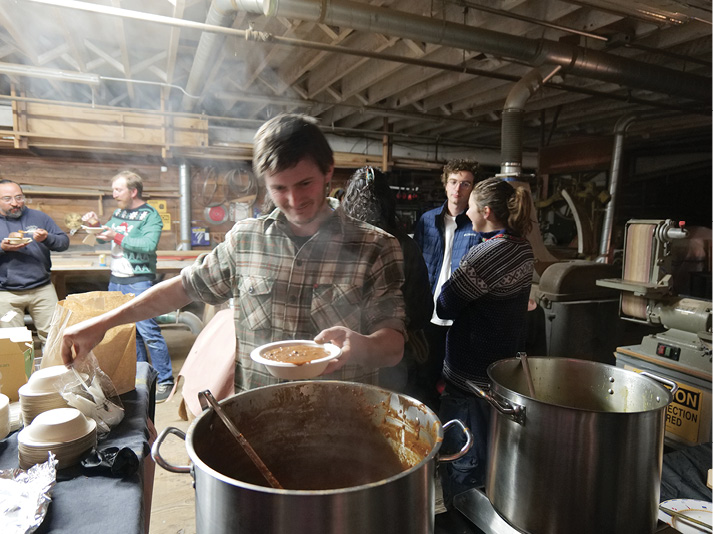
A few days after my visit I called Spaulding and Bill Edinger answered the phone. Bill is the president of Spaulding Marine Center. I told him that I was writing this article and wanted some clarification for publication. Then I introduced myself as the woman to whom he gave the free coffee cup and he relaxed. He told me about a donation from the wife of the late Hank Easom, which will be put into a trust account. The account will provide seed money for an eventual endowment that is meant to be used to support Boatworks 101.
I serve a lot of tea and coffee from the Dura Mater Café. If you walk by her sometime or sail by where we are anchored, call me on the radio and feel free to raft up. I will serve you using the Spaulding Marine Center cup. All you have to do is ask.
About Those Other Programs
In March of 2018 I travelled to Port Townsend, Washington, in the Pacific Northwest in order to write about the Race To Alaska. Also known as the R2AK, it is a boat race which starts in that town and ends up in Ketchikan, Alaska. No engines are allowed. Owners of racing boats have their engines removed in order to participate. Seriously. Now there’s a race for you. Although that is not included in my bailiwick here in the San Francisco Bay, I would highly recommend following it: https://www.youtube.com/watch?v=Hg5Uug5sbX8
While I was up there, I visited the Northwest School of Wooden Boat Building in Port Hadlock, Washington. I interviewed two young people who were learning to build wooden boats. The tuition to do so is $25,400/year.
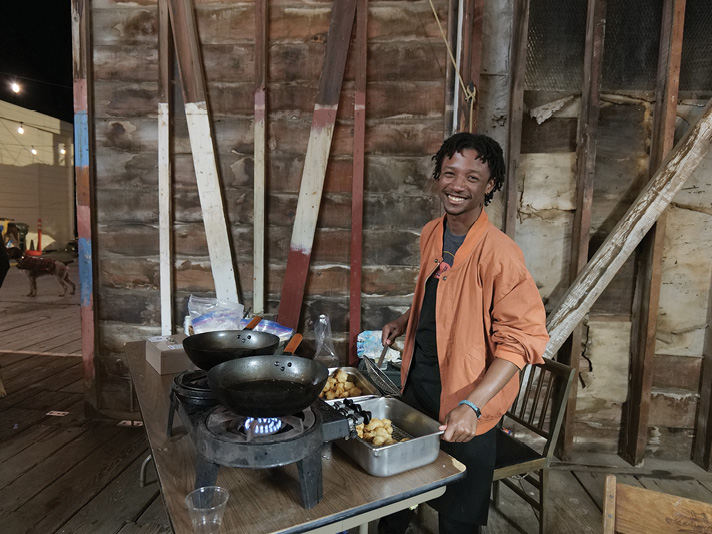
Pete Brewster mentioned the IYRS School of Technology & Trades in Rhode Island, so I did a little research. My understanding is that the IYRS acronym once stood for International Yacht Restoration School, but it seems to have broadened its mission. Its programs seem now to focus on more than just boats, and include a more general mission of “making, building, restoring and maintaining, using both traditional and modern materials from wood to composites and carbon fiber.”
The tuition at the IYRS is approximately $27,000 per year after tools and materials are factored in.
Here in the Bay Area the Spaulding Marine Center pays its students to attend its nine-month program, then provides an informal job placement service with local professional marine service providers.
I’ve spoken with a couple of the local marine professionals who have provided employment to Spaulding graduates, and learned that the placement process has not proven to be altogether seamless. I’ll look into this further to see what the glitches were and report back here. Might people who have “skin in the game,” that is, people who pay tuition, be more appreciative of the opportunities gained than people who are paid for the privilege? I don’t know, but I’ll ask around. If anyone would care to weigh in on these issues, please do write. No anonymous letters, please. We’ll respect your privacy but this column has a moderator: Me.
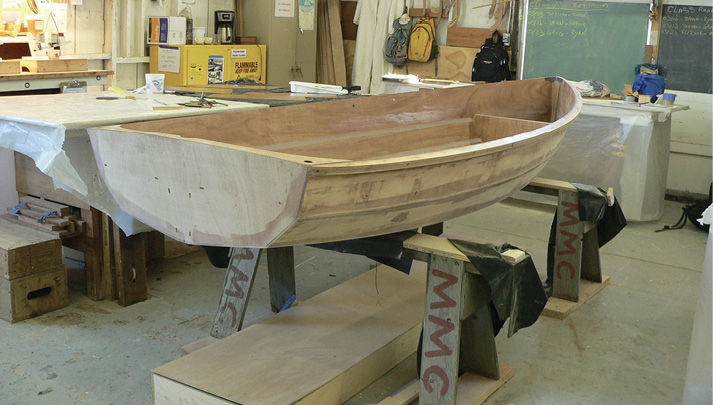
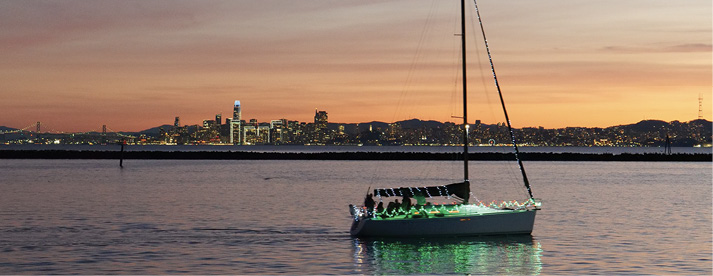
There were holiday boat parades all around the Bay Area this year. People seem to be making up for the COVID years by doubling down on the decorations. Two nights after the holiday party at Spaulding Marine Center I took photographs of the decorated boats in Potrero Reach. There were about 20 decorated boats exiting from their private docks, RYC docks and Brickyard Cove. The year before COVID there was a bigger turnout with more elaborate decorations, but the people who came out this year were having a good time. I photographed them against a remarkable sunset, all from the race committee platform down on the seawall overlooking the City straight ahead and Mount Tamalpais to the west. If you were lucky enough to have a view anywhere around the San Francisco Bay you might agree that the sky provided a real spectacle that evening.
Afterward my husband and I went for dinner at BiancoVerde, the Italian restaurant located in the Hotel Mac. The Hotel Mac is a historic hotel in Point Richmond, built in 1911 and listed in the National Register of Historic Buildings. The hotel was closed for years and I’ve been telling everyone that I know, that it’s BACK!
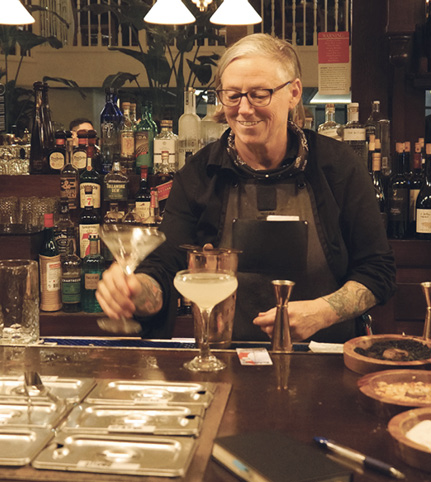
There were three bartenders working nonstop the whole time we were there. Here is Robin Biles, who was impressively coordinated and calm as she prepared drinks behind the bar.
Richmond Yacht Club Small Boat Midwinters
Every year, while other yacht clubs have what are called Midwinter Series, Richmond Yacht Club goes small. Lots of sailors who own larger keel boats also have smaller boats, which are kept in the club’s large “small boat yard.” There are lasers, snipes, tiny little El Toros that big people and little people both race and every type of dinghy imaginable. Each has its own discrete little numbered parking space. Masts that are too long for the parking space are kept along the fence. Harbormaster Danny Harris maintains dominion over all.
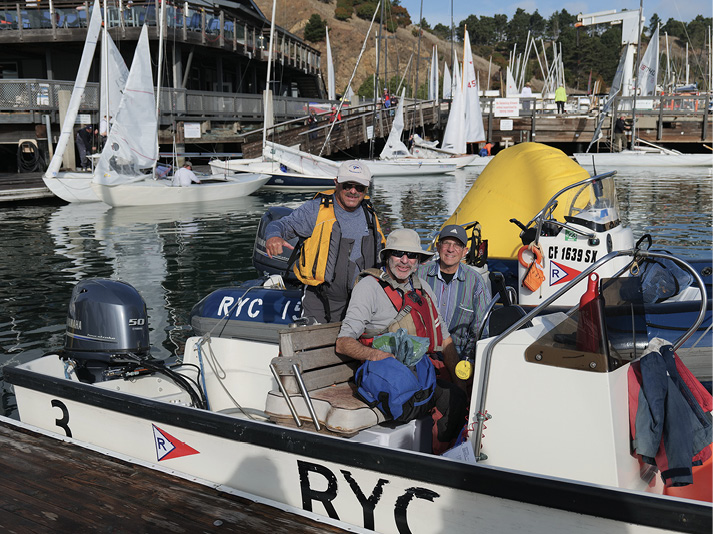
The first day of RYC’s Small Boat Midwinters Series was held on Dec. 3 and the parking lot was jammed. Cars lined Brickyard Cove Road and when I arrived sails were flapping and all sensible adults were pulling on wetsuits. Small boats are just that: Small. And since people like going fast? Their small boats have big sails. If you know what that means, you know that people who like going fast on small boats often end up in the water. And in early December the water out there on the SF Bay is COLD! Hence the wetsuits, and the reason all support boats were in attendance.
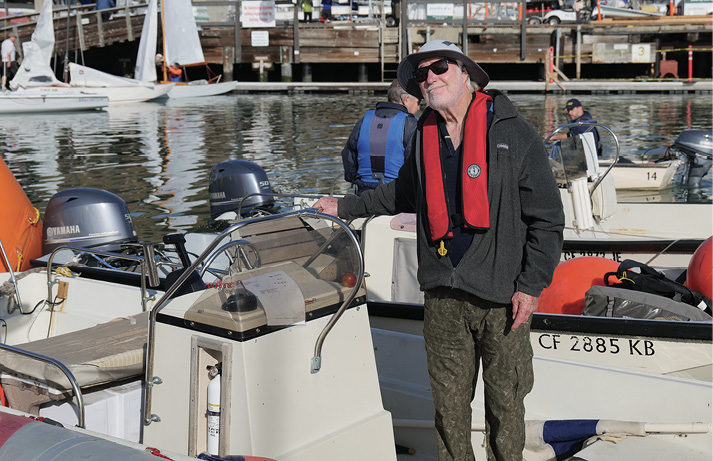
There are three separate courses: Keller Cove, Potrero Reach and Southampton with 112 boats registered. They came from all over: Lake Washington in West Sacramento, Oroville’s Butte Sailing Club and the Park City Sailing Association of Utah. There was also a boat representing North Coast Yachts of Rhode Island. Have you got a small boat? The Small Boat Midwinters advertises itself this way: Four fun Sundays of racing on the Richmond Riviera. Trophies for skippers and crew. First time racing a dinghy? NO PROBLEM! Friendly race committee, easy sailing instructions, light wind.
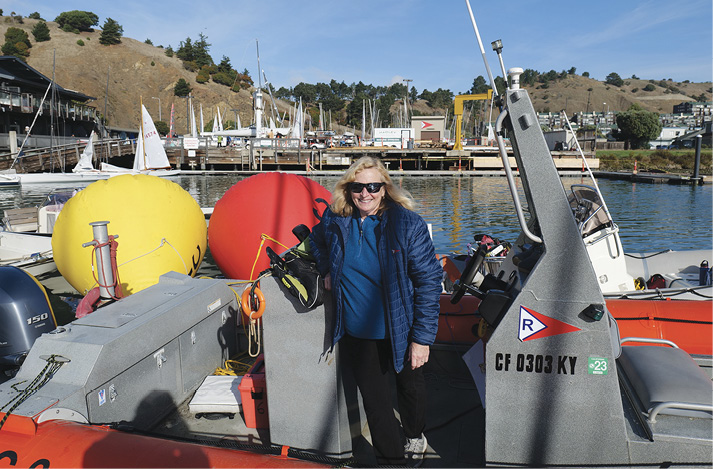
I hope to see more participants from upriver next year.
Ode To An Engine
You may recall from last month’s column that my boat’s engine has been removed for a rebuild. I planned to write about the process here. However, I have been told that it cannot be rebuilt after all. This is difficult for me to accept, but I realize that I must move on.
Dura Mater was built in 1979. The engine she came with was removed and rebuilt, then re-installed in 1997. It cost $661.13 to reinstall. Seriously. I know this because I have the receipt. I’d show you except I am only allowed 16 photos.
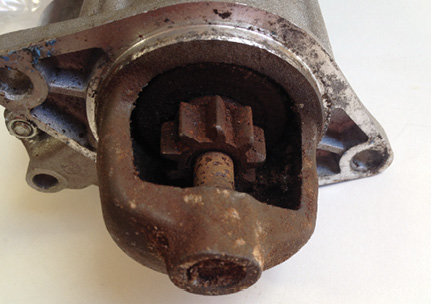
I have a lot of history with this engine. It has taken Dura Mater and me down the coast to Santa Barbara and Santa Cruz Island, up to Bodega Bay twice and up river to the Delta six times. During all those trips my engine has always come through for me when I needed it. However, I have been told that engines have lifespans, and raw water-cooled engines in salt water are at more risk than others. And it is 45 years old. So, okay, I’m a little sad about giving it up, but I guess it’s time for DM to find another engine. If you have one sitting around in your garage, let me know.
However, I do plan to write about the engine memories I will always carry with me. But not this month. Engine topic for next month? That time the starter motor kept rusting out. Stay tuned.
Before I end this column, please note that I made a terrible error last month. I posted a photograph of the very gracious people who work at the restaurant Sausalito Seahorse, which is located at 305 Harbor Drive. I mistakenly identified it as the Fish Restaurant. My apologies to all concerned. Oh, gosh. I’d better go over there again, apologize in person and of course have another delicious meal.
In the meantime, enjoy your time on the water and please write to tell me about your own boating experiences. I can be reached at jackie@yachtsmanmagazine.com. Thank you for reading, and let’s all be careful out there.



